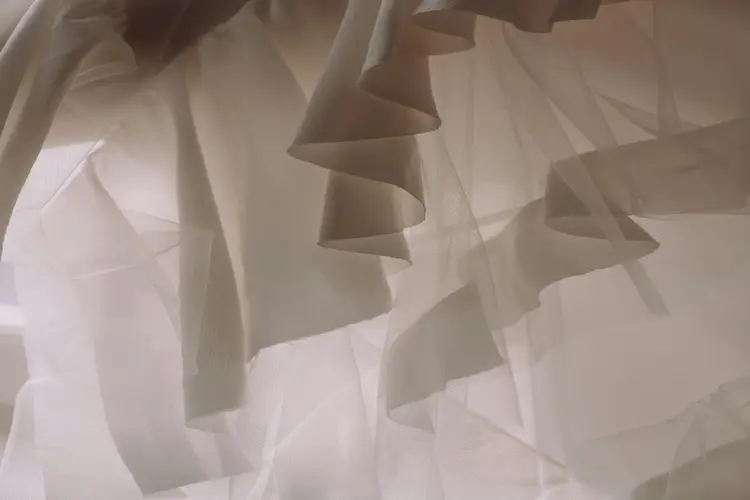What Exactly Is Organza Fabric?
Organza fabric is a lightweight, sheer fabric with a plain weave that is prized for its transparent and delicate feel. It’s commonly used to overlay thicker garments or in various household textiles. Originally crafted from silk, modern organza can also be made from synthetic fibers such as polyester and nylon.
Because of its delicate nature, organza should not be machine washed and is best cared for through hand washing or dry cleaning. Its weave features evenly sized warp and weft threads, and its quality is assessed by the number of holes per inch (HPI) rather than thread count. Higher HPI values indicate finer organza fabric.
The term “organza” is connected to “organzine,” which now refers to any silk thread spun using a simple twist method. It originated along the Silk Road, an ancient trade route stretching from China to Europe. Interestingly, the name “organza” doesn’t come from a Chinese language source but is derived from “Urgang,” a town in Turkestan renowned for its vibrant silk markets.
During the Middle Ages, Westerners adapted variations of “Urgang” into regional terms like “organza,” while “organzine” specifically denotes the spinning technique used for its threads. In Western culture, organza has been highly valued for making wedding gowns, evening wear, and other garments that benefit from its lightweight and semi-transparent qualities.
Because organza is so delicate, it is susceptible to damage. It’s crucial to handle organza fabrics carefully to avoid snags and to store them wrapped in protective materials such as muslin to preserve their quality.

How is organza fabric produced
The way organza fabric is made depends on the material used. When polyester is the base, the process begins with synthesizing non-organic components in a laboratory. Petroleum oil is refined to produce textile yarn, with the use of various machines and chemicals throughout.
In contrast, silk production is entirely organic and devoid of synthetic chemicals. It starts with silkworms, which naturally produce silky cocoons. These cocoons are boiled or soaked in hot water, and then unraveled to create continuous fiber strands.
Once the silk or synthetic fibers are turned into finished textile yarn, the process for making organza becomes standardized. The next step involves twisting two fibers in opposite directions. This twisting causes the fibers to cling together naturally due to opposing kinetic forces. The yarn is then combed and treated with acid to increase its stiffness. This stiffness sets organza apart from other silk fabrics, although this acid treatment may not be needed for already stiff polyester or nylon fibers.
To qualify as organza, whether silk or synthetic, the fabric must undergo specific weaving techniques. Factors such as seam appearance, stiffness, and puckering are meticulously controlled, often requiring hand weaving. While machine weaving is feasible, it generally results in lower-quality organza fabric.
How Organza Fabric is Utilized
Organza is widely utilized in the Western world, especially in wedding dresses to introduce folds and airy textures to the attire. Its sheer nature makes it a preferred choice, commonly dyed in bright white but also available in a spectrum of colors.
In evening wear, organza is valued for its ability to create elaborate ruffles and intricate folds, often seen in overlays—shawls worn over dresses—with vibrant designs.
Moreover, organza plays a significant role in stage costumes, often employed in underskirts and specialized dancewear like tutus. Beyond clothing, it is also employed in home decor applications such as curtains and lampshades.
Where Is Organza Fabric Produced?
Organza, originally a silk fabric, has long been primarily manufactured in East Asia. Ancient cultures in India and China were early leaders in silk production, a tradition that remains strong in these regions today. Silk’s value was so significant that it spurred the creation of trade routes like the Silk Road, facilitating organza’s spread to Europe during the Middle Ages and Renaissance.
While silk production has since expanded globally, China and India continue to dominate as the largest producers and exporters of organza fabric. In China, textile mills in the Yangtze River region and Zhejiang province spin organza yarn. Meanwhile, India produces a coarser form of organza yarn in Bangalore, some of which is locally processed into fabric. However, the majority of organza yarn is exported to major factories in China, Pakistan, Indonesia, or Bangladesh, where it is woven into garments destined for global markets.
When organza fabric is made from materials like polyester and nylon instead of silk, the manufacturing process shifts significantly. Although polyester and nylon were originally developed in the United States and are still spun into organza yarn to some extent there, the predominant production now occurs in China.
China is home to hundreds of textile companies that dominate global polyester production and lead in exporting nylon. Once these synthetic materials are transformed into organza yarn in China, they are usually processed into finished textiles within the country as well.
What is the Price of Organza Fabric?
The price of organza fabric fluctuates depending on the material and market dynamics. Although organza enjoys a steady global supply, it remains a specialty textile with higher prices reflecting its niche appeal. Specifically, silk organza commands a premium due to its luxurious feel and eco-friendly nature, but its production involves intensive labor, contributing to its elevated cost.
Conversely, nylon and polyester offer more economical alternatives. Organza crafted from these synthetic fibers is typically less expensive than silk and competitively priced among fabrics using similar materials.
What Varieties of Organza Fabric Exist?
Organza fabric is created using a range of materials, leading to several unique variations:
- Material choices: Originally derived from silk, modern organza is primarily made from polyester or nylon.
- Spark organza: Contains embedded bright sparkles in its weave.
- Crystal organza: Shimmers without the addition of sparkles.
- Pearl organza: Recognized for its pearlescent color, resembling the sheen of real pearls.
What Environmental Impact Does Organza Fabric Have?
The environmental impact of organza fabric varies depending on the materials used in its production. Organza itself refers to a weaving pattern rather than a specific material, so its environmental footprint is influenced by the fibers utilized.
Synthetic fibers such as nylon and polyester are notorious for their harmful environmental effects. Derived from non-renewable petroleum oil, their production demands substantial energy and resources for extraction and refining. This process releases toxins into the environment and poses risks to workers. Additionally, these synthetic fabrics are non-biodegradable, persisting in the environment indefinitely after disposal.
In contrast, silk production is considered environmentally sustainable. Silk is obtained from silkworms that exclusively feed on pesticide-free mulberry leaves. The silkworms produce cocoons, and their harvesting does not release toxins or non-biodegradable materials into the environment. While ethical concerns surround the method of boiling silkworms alive during harvesting, silk distinguishes itself environmentally due to its biodegradability and minimal environmental impact throughout its lifecycle.
Certifications for Organza Fabric
If organza fabric is made from synthetic materials such as nylon or polyester, it can only be certified by organizations like the Global Recycle Standard (GRS), which verifies products made from 100% recycled materials. Synthetic fabrics cannot receive certifications for being organic or non-GMO due to their composition.
However, organza crafted from silk can attain organic certifications from various organizations and may meet the criteria for USDA organic certification in the United States. Moreover, certain types of silk produced in India may qualify for Silk Mark certification, which acknowledges manufacturers following safe and sustainable silk production methods.
You may also like:
- Supima Cotton: Properties, Production, and Origins
- Using a Seam Ripper: A Step-by-Step Guide
- Different Types of Sewing Machines
- Guide To Sewing Machine Needles Size, Types, And Uses
- Sewing Machine Parts And Functions
- Micromodal Fabric: Characteristics, Production, and Origins
- Yarn Manufacturing Process
- Varieties of Woven Fabrics and Their Applications
- Non Woven Geotextile Fabric
- What is Sisal Fiber? Properties, Structure, and How It Made?
- How to Tie Dye Shirts: A Step-by-Step Guide
Share this Article!

